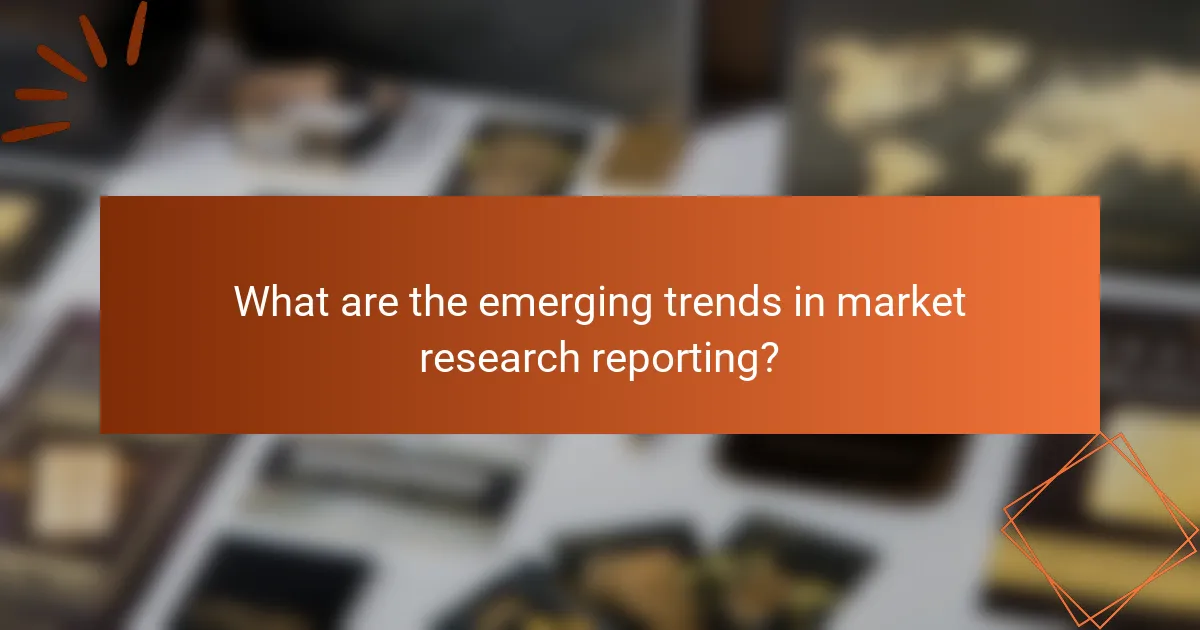Market research reports play a crucial role in enhancing stakeholder engagement by delivering clear and actionable insights that guide decision-making. By incorporating essential elements such as an executive summary and thorough data analysis, these reports ensure that stakeholders can easily grasp market dynamics and align their strategies effectively.

How can market research reports enhance stakeholder engagement?
Market research reports can significantly enhance stakeholder engagement by providing clear insights that inform decision-making. By presenting relevant data in an accessible format, these reports help stakeholders understand market dynamics and align their strategies accordingly.
Clear communication of insights
Effective communication of insights is crucial for engaging stakeholders. Reports should distill complex data into straightforward findings that highlight key trends and implications. Using plain language and avoiding jargon ensures that all stakeholders, regardless of their expertise, can grasp the essential points.
Consider summarizing findings in bullet points or executive summaries to facilitate quick understanding. This approach allows stakeholders to quickly identify the most relevant information without sifting through extensive data.
Visual data representation
Visual data representation enhances comprehension and retention of information. Charts, graphs, and infographics can illustrate trends and comparisons more effectively than text alone. For instance, a bar graph showing market growth over time can convey changes at a glance, making it easier for stakeholders to visualize performance.
Utilizing color coding and clear labels in visual aids can further improve clarity. Ensure that visuals are not overly complex; simplicity often leads to better engagement and understanding.
Tailored content for specific audiences
Tailoring content to specific audiences is essential for maximizing engagement. Different stakeholders may have varying interests and levels of expertise, so customizing reports can make the information more relevant. For example, executives may prefer high-level summaries, while analysts might require detailed data breakdowns.
To achieve this, consider creating multiple versions of the report or including sections that address the needs of different groups. This targeted approach can foster deeper connections and encourage stakeholders to act on the insights provided.

What are the key components of compelling market research reports?
Compelling market research reports consist of several essential components that enhance clarity and engagement for stakeholders. Key elements include an executive summary, a detailed methodology section, and thorough data analysis and interpretation.
Executive summary
The executive summary provides a concise overview of the entire report, highlighting the main findings and recommendations. It should be engaging and informative, allowing stakeholders to grasp the report’s essence quickly.
When writing the executive summary, focus on the key insights and implications of the research. Aim for clarity and brevity, typically keeping it to one or two pages, depending on the report’s length.
Methodology section
The methodology section outlines the research design, data collection methods, and analytical techniques used in the study. It is crucial for establishing the credibility and reliability of the findings.
Include details such as sample size, demographic information, and any tools or software employed. Transparency in this section allows stakeholders to assess the validity of the research and its applicability to their needs.
Data analysis and interpretation
Data analysis and interpretation involve examining the collected data to extract meaningful insights. This section should clearly present the findings using charts, graphs, or tables to enhance understanding.
Consider using statistical measures to support your conclusions and highlight trends or patterns. Be cautious of over-interpreting data; ensure that the analysis remains grounded in the evidence presented.

How to choose the right market research report for your needs?
Choosing the right market research report involves understanding your specific objectives, evaluating the credibility of the report, and considering its relevance to your industry. This ensures that the insights you gain are actionable and aligned with your business goals.
Identify specific objectives
Start by clearly defining what you want to achieve with the market research report. Are you looking to understand consumer behavior, assess market trends, or evaluate competitive landscapes? Having specific objectives will guide your selection process.
For example, if your goal is to launch a new product, focus on reports that provide insights into customer preferences and market demand. This targeted approach helps you avoid irrelevant information and saves time.
Evaluate report credibility
Assessing the credibility of a market research report is crucial for ensuring the reliability of its findings. Look for reports published by reputable firms or organizations known for their research integrity.
Check for references, methodologies, and sample sizes used in the report. A credible report typically includes detailed information about how the research was conducted, which can help you gauge its validity. Avoid reports that lack transparency or are overly promotional.
Consider industry relevance
Ensure that the market research report is relevant to your specific industry. Different sectors have unique dynamics, and insights from one industry may not apply to another.
For instance, a report focused on the technology sector may not provide valuable insights for the food and beverage industry. Look for reports that specifically address your market or include case studies relevant to your field to maximize the applicability of the findings.

What are the pricing ranges for market research reports?
Market research reports can vary significantly in price, typically ranging from free resources to several thousand dollars for comprehensive analyses. Understanding these pricing structures helps stakeholders choose the right reports based on their needs and budget.
Free reports vs. paid subscriptions
Free reports often provide basic insights and data but may lack depth and comprehensive analysis. They are useful for initial research but might not meet the needs of businesses requiring detailed information.
Paid subscriptions generally offer more extensive data, expert analysis, and ongoing updates. Prices for these subscriptions can range from a few hundred to several thousand dollars annually, depending on the provider and the report’s complexity.
Factors influencing report pricing
Additionally, the frequency of updates and the inclusion of proprietary data can also affect pricing. Custom reports tailored to specific business needs typically command higher fees compared to off-the-shelf reports.
Examples of pricing from leading providers
Leading market research firms offer a range of pricing options. For instance, basic reports from companies like Statista or IBISWorld may start around USD 500, while comprehensive studies from firms like Gartner or Forrester can exceed USD 5,000.
Some providers also offer tiered pricing based on the level of detail and additional features, such as access to exclusive webinars or consultation services. It’s advisable to compare offerings to find the best value for your specific requirements.

How to effectively present market research findings?
Effectively presenting market research findings involves clear communication, engaging storytelling, and interactive elements that resonate with stakeholders. By focusing on these aspects, you can ensure that your audience understands the insights and implications of your research.
Utilize storytelling techniques
Storytelling techniques can transform raw data into relatable narratives that capture attention. Begin by framing your findings within a story arc, highlighting the problem, the research process, and the resolution through your insights. This approach helps stakeholders connect emotionally with the data.
For example, instead of simply presenting statistics, share a case study that illustrates how a particular trend affects a specific demographic. This method not only makes the data memorable but also emphasizes its relevance to the audience.
Incorporate interactive elements
Incorporating interactive elements, such as polls or live demonstrations, can significantly enhance engagement during presentations. Tools like interactive dashboards or real-time surveys allow stakeholders to explore data in a hands-on manner, making the findings more impactful.
Consider using platforms that enable audience participation, such as Slido or Mentimeter, to gather instant feedback or questions. This not only keeps the audience involved but also tailors the discussion to their interests and concerns.
Engage with Q&A sessions
Q&A sessions provide an opportunity for stakeholders to clarify doubts and express their perspectives on the research findings. Allocate sufficient time for questions to foster an open dialogue, which can lead to deeper insights and a better understanding of the data.
Encourage participants to ask questions throughout the presentation, rather than waiting until the end. This approach can create a more dynamic atmosphere and ensure that the discussion remains relevant to the audience’s needs.

What are the emerging trends in market research reporting?
Emerging trends in market research reporting focus on leveraging technology and data-driven insights to enhance clarity and stakeholder engagement. These trends include the increased use of AI analytics, which allows for more efficient data processing and deeper insights into consumer behavior.
Increased use of AI analytics
The integration of AI analytics in market research reporting is transforming how data is gathered and interpreted. AI tools can analyze vast amounts of data quickly, identifying patterns and trends that may not be immediately visible to human analysts.
Companies are increasingly adopting AI-driven platforms to automate data collection and analysis, which can lead to faster reporting cycles and more accurate insights. For instance, AI can help predict consumer preferences by analyzing past purchasing behavior, allowing businesses to tailor their strategies effectively.
However, organizations should be cautious about over-relying on AI without human oversight. It’s essential to ensure that AI-generated insights are validated by experienced analysts to avoid misinterpretations. Balancing technology with human expertise is key to maximizing the benefits of AI in market research reporting.


